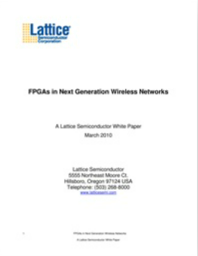FPGAs in Next Generation Wireless Networks
In addition to voice connectivity, digital cellular wireless networks such as GSM and its enhancement, GSM-EDGE, can now provide increased data speeds up to a (theoretical) limit of 384Kbps. Third generation mobile networks, such as CDMA2000 and WCDMA or UMTS (Universal Mobile Telecommunications Standards) and TDSCDMA (China only) are currently being deployed worldwide.
These systems offer services such as video streaming, Internet browsing and, by using a technique called High Speed Packet Access (HSPA), they can in theory deliver downlink speeds up to 14.4Mbps.
Download this whitepaper to learn more.
Read More
By submitting this form you agree to Lattice Semiconductor Corporation contacting you with marketing-related emails or by telephone. You may unsubscribe at any time. Lattice Semiconductor Corporation web sites and communications are subject to their Privacy Notice.
By requesting this resource you agree to our terms of use. All data is protected by our Privacy Notice. If you have any further questions please email dataprotection@techpublishhub.com
Related Categories: Cellular, Communication, Embedded, Power, Processors

More resources from Lattice Semiconductor Corporation
An FPGA Approach to Implementing Time-Critical Functions in Multi-Sensor Mobile Designs
Today's massive smartphone market is often depicted as a hotbed of innovation for the continual advancement of cost-effective, power efficient solu...
Implementing High-Speed DDR3 Memory Controllers in a Mid-Range FPGA
Implementing a highspeed, high-efficiency DDR3 memory controller in a FPGA is a formidable task. Until recently, only a few high-end (read: expensi...
MachXO™: Optimized Programmable Devices for Bus Interfaces, Bridges and Control
Bus bridging, interfacing and control are common functions in many electronic systems. The use of these functions spans virtually every end market ...
